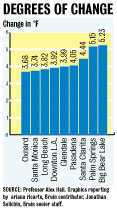Through complex equations and several data sets, UCLA researchers have programmed a supercomputer to predict the future of Los Angeles ““ the future temperature, that is.
Alex Hall, an associate professor of atmospheric and oceanic sciences, recently led a study revealing that the L.A. area will experience a 4 to 5 degree increase in temperature by the mid-century.
The study was funded and commissioned by the City of Los Angeles and Los Angeles Regional Collaborative for Climate Action and Sustainability.
Since the temperature increase will occur in the foreseeable future, planning for these changes is becoming more pertinent in the city, said Paul Bunje, director of UCLA’s Center for Climate Change Solutions.
The predictions, which were made for the years 2041 to 2060, were achieved using a supercomputer that considered factors like the motion of the atmosphere, heat movement and the way that the sun shines on the earth.
Studies that were conducted in the past only allowed researchers to predict climate change along a 31- to 62-mile-wide area. In contrast, the UCLA study used high-resolution programming to predict changes along 1.2-mile areas within the L.A. region, Hall said.
The smaller scale is more effective for predicting weather in the L.A. region because of the complex and diverse environment. For instance, the predictions are specific for coastal areas like Santa Monica as well as inland areas like Bakersfield.
The study indicates that inland areas will experience the most severe increases in temperature, while areas along the coast will have moderate increases. Inland areas should also expect to have four to five times more heat wave days a year, Hall said.
Greenhouse gases emitted by the burning of fossil fuels are the main cause for the predicted temperature increase, Bunje said.
Richard Ambrose, a professor at the Environmental Science and Engineering Program at the UCLA School of Public Health, said the predicted temperature changes will also have effects on the oceans, including an increase in sea levels, change in water and air temperature and an increasing acidity in the ocean water.
These factors pose a threat to the lives of small organisms that live in the water, he said, which in turn affect the lives of common animals that rely on them.
Researchers in the study anticipate the projected changes in climate will alter infrastructure within Los Angeles.
Rising sea levels may also force homes and businesses on the coast to make changes in infrastructure to adapt to the rising sea levels. These include building sea walls, raising existing structures and engineering buildings in a manner that withstands erosion, Ambrose said.
Since research has shown that the temperature increase is unavoidable because of the prolonged burning of fossil fuels, the city must learn to adapt to these changes to create a more sustainable future, Bunje said.
The city may also adopt other strategies to save energy such as creating greater access to air-conditioned spaces like libraries and cooling centers, insulating homes and building lightly colored roofs to reflect the sun’s rays, he added.
Bunje says he is optimistic about the city’s ability to adapt because the changes, like construction of parks and recreation centers, will increase the quality of life for citizens.
“So although the increase in temperature is inevitable, it gives us a great opportunity to construct a better world,” Bunje said.
